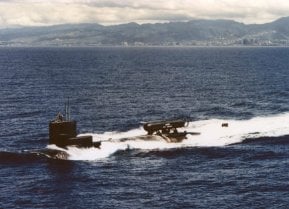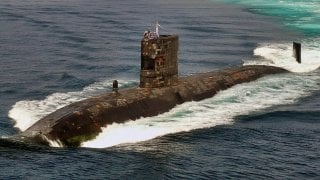Six Foot 'Hole': A Nuclear Submarine Was Several Damaged Tracking Russian Ships
In 2015, the British submarine HMS Talent, a Trafalgar-class hunter-killer, collided with floating ice while tracking Russian ships, resulting in a six-foot hole at the top of its conning tower. Despite the damage, the submarine continued to serve the Royal Navy until its decommissioning in 2022.
What You Need to Know: In 2015, the British submarine HMS Talent, a Trafalgar-class hunter-killer, collided with floating ice while tracking Russian ships, resulting in a six-foot hole at the top of its conning tower. Despite the damage, the submarine continued to serve the Royal Navy until its decommissioning in 2022.
-The Trafalgar-class submarines, constructed during the Cold War, were known for their reduced acoustic signature and powerful armament, including the Tomahawk cruise missiles and upgraded Spearfish torpedoes.
-Despite the incident, the HMS Talent proved resilient, showcasing the durability and capabilities of the Royal Navy’s submarines.
Trafalgar-Class Submarine HMS Talent Strikes Iceberg, Sustains Severe Damage
Although modern military submarines largely feature the most cutting-edge technologies available, these mighty vessels are not immune to accidents. In 2015, the United Kingdom’s HMS Talent suffered a blow when it collided with floating ice while tracking Russian ships. In images widely circulated on social media, the Trafalgar-class hunter-killer submarine appeared to have a severely damaged fin. The collision inflicted a six-foot large hole at the top of the ship’s conning tower. Despite this unfortunate event, the British submarine continued to service the Royal Navy until 2022.
Overview of the Trafalgar-class Submarines and Capabilities
As the sixth Trafalgar-class submarine constructed in the early 1970s, HMS Talent was designed as the Cold War arms race was heating up. These powerful boats were designed largely based on the preceding Swiftsure class. HMS Trafalgar, the lead submarine of her class- was completed in 1983, followed by six sister ships. The UK-based manufacturer Lickers Shipbuilding and Engineering at the Barrow-in-Furness shipyard constructed each Trafalgar submarine from start to finish.
Like the Swiftsure boats, the Trafalgar submarines feature the Rolls-Royce PWR1 Core three. Notably, however, the newer ship class possesses a reduced acoustic signature, which makes these submarines harder for adversaries to detect.
HMS Talent, like her sister ships, measured about 280 feet in length with a dived displacement of 5,200 long tons. Talent, along with HMS Torbay, HMS Trenchant, and HMS Triumph were all fitted with the SONAR 2076 system, which has previously been claimed to represent a “step change” over past sonars according to its manufacturer BAE Systems. Over the years, the Trafalgar ships underwent several upgrades to incorporate the latest and greatest technologies. Back in 2021, HMS Talent would carry out trials of the upgraded Spearfish torpedo variant off the coast of Scotland. According to Naval Technology, the British submarine fired four of these weapons, helping the torpedo achieve Initial Operating Capability with the service.
The newest Trafalgar-class submarine the HMS Triumph, is equipped with an even more powerful armament. As detailed by the Royal Navy, “HMS Triumph carries an impressive arsenal to quell any threat. Tomahawk cruise missiles can pick off targets from a range of up to 1,000 miles, and local surface targets can be dealt with by the onboard Spearfish and Harpoon missiles.”
While the HMS Talent collision was a blow to the Royal Navy, another British submarine collision was shortly followed. In 2016, the Astute-class nuclear attack SSN HMS Ambush struck a merchant vessel near Gibraltar, suffering external damage. Although no sailors were injured and the submarine’s nuclear plant was not affected, this collision followed closely on the heels of the HMS Talent incident.
The Royal Navy may not have the best luck when it comes to submarine safety out at sea, however, its ships represent some of the best in service across the globe. Today, the Astute-class is recognized for its armament power, advanced electronic support measures suite, and quiet acoustics. These submarines will undoubtedly remain an integral component of the Royal Navy for decades to come.
About the Author: Maya Carlin
Maya Carlin, National Security Writer with The National Interest, is an analyst with the Center for Security Policy and a former Anna Sobol Levy Fellow at IDC Herzliya in Israel. She has by-lines in many publications, including The National Interest, Jerusalem Post, and Times of Israel. You can follow her on Twitter: @MayaCarlin.
Image Credit: Creative Commons and/or Shutterstock.


